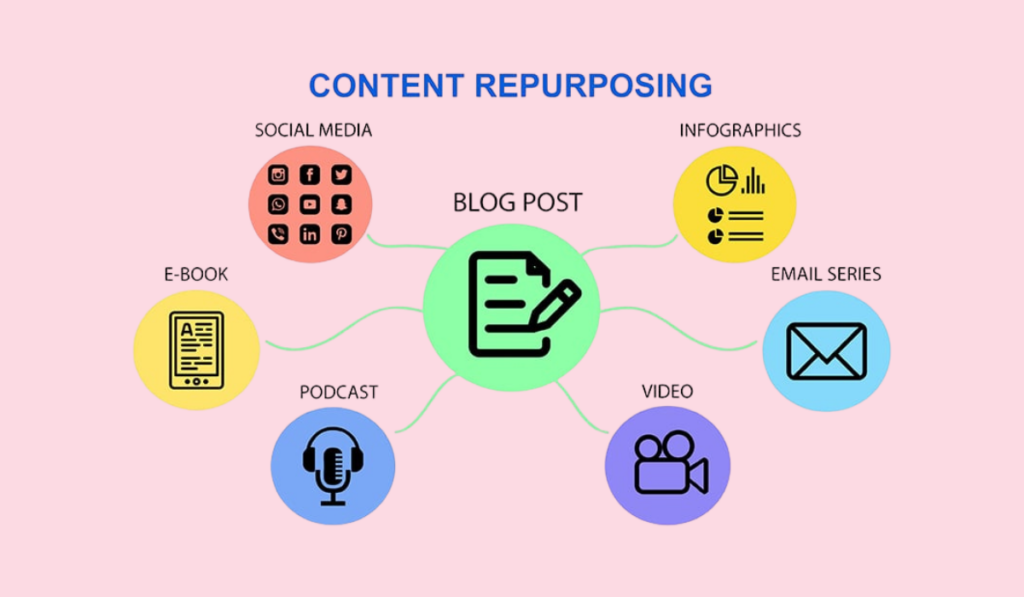The consistency of coming up with good quality content proved to be a major hindrance for marketers, content creators, and companies. Thankfully, the smarter alternative to staying visible and relevant without having to constantly reinvent the wheel is content repurposing. This strategic approach gives you more mileage out of your content by transforming it into new formats and distributing that across various platforms.
In this article, we describe what content repurposing is, its significance, as well as actionable content repurposing strategies you can implement today.
What Is Content Repurposing

Content Repurposing is the art of taking a single piece of content and changing it into various formats or for different audiences and platforms. The idea is to extend the content’s life, reach, and performance through multiple delivery methods.
A blog post can be turned into a video, an infographic, a podcast episode, or a social media post. In each case, the core message is unchanged, but the form is changed to suit different content consumption preferences.
Benefits of Content Repurposing
Maximize Content ROI
Repurposing increases the worth of your content investment by taking one piece and turning it into several, amplifying the ROI on your effort and time.
Reach A Broader Audience
Different users may consume different content formats. Some will read, some will watch videos, or others may choose to listen to podcasts. Repurposing guarantees that your message finds a wider audience.
Give Content More Life
Instead of letting valuable content grow stale or forgotten, repurposing gives it new energy to stay alive and be kept discoverable.
Boost SEO Performance
Repurposed content can be optimized with relevant keywords, internal links, and updates, leading to greater visibility and authority in search engines.
Reinforce Core Messages
For the brand and the message to remain firmly stored in prospect memory, it is good practice to hit the same message through different media.
Examples of Effective Content Repurposing
- Take a blog post and put it into a video or podcast
- Take a look through a webinar and make short clips for social media
- Break an eBook into bits of blog articles
- Turn a research report that is heavy on data into an infographic
- Tailor several how-to articles into an email course
Top Content Repurposing Strategies
To make the most of your content, use the following strategies to repurpose effectively and strategically.
Content Audit
Begin with a check on your current existing contents to find high-performing-ones along with evergreen content. Track down blog posts, videos, or content on social media, which are still generating traffic and engaging the audience, then find out which among these is capable of refreshing or remaking.
Tip to act: It is important to use such tools as Google Analytics, Ahrefs, or SEMrush to find the top content in terms of traffic, backlinks, or shares.
Segment Longer Content Into Smaller Portions
Long blog posts, whitepapers, or videos can be segmented into smaller, bite-sized content.
Example Breakdown:
- Subheadings of a blog post become separate tips on social media.
- Stats or quotes become shareable visuals.
- Sections can be taken and short formal videoed such as these.
Combine Related Content Into a Comprehensive Resource
Group related pieces of content to create something new and more valuable.
Ideas:
- Transforming a blog series into an eBook for download
- Building a pillar page that encompasses various related topics
- Creating a webinar/course centered around pre-existing blog content
Transform Written Content Into Visual or Audio Formats
Adapting written material to adapt it to visualization and audio not only boosts engagement but also makes your content more accessible.
Some suggestions include:
- Convert how-to guides into explainer videos.
- Adapt a blog into a podcast.
- Create infographics or charts out of stats.
Adapt Content for Platform-Specific Audiences
Every platform has its own audience expectations and content styles. Tailor your content accordingly.
Platform Examples:
- LinkedIn: Professional insights, data-driven posts
- Instagram: Visual storytelling, carousel graphics
- TikTok: Quick tips, behind-the-scenes content
- YouTube: In-depth tutorials or interviews
- Twitter: Short-form tips or threads
Refresh and Update Older Content
Be sure to refresh your old content before using it in a different way since you want to make certain it is accurate, relevant, and oriented toward current search engines.
Checklist:
- Update statistics and examples
- Optimize with current SEO best practices
- Include internal links to newer content
- Refresh visuals and format
Utilizing Tools for Streamlining Processes
There are many tools available for content repurposing automation or simplification.
- Canva: Design social graphics, carousels, and infographics.
- Lumen5: converting blog posts to videos with an assist from AI.
- Descript: For the conversion of audio and/or video writing.
- Repurpose.io: An automated way to distribute content across platforms.
Content Repurposing Workflow: Step-by-Step Guide
Audit and Identify Repurposable Content
Start by reviewing your content library to find:
- High-performing blog posts
- Evergreen content
- Videos or podcasts with good engagement
- Content with outdated but fixable information
Tools to Use: Google Analytics, SEMrush, Ahrefs, BuzzSumo
Set Clear Repurposing Goals
Define what you want to achieve through repurposing:
- More traffic generated through search engines
- Greater enjoyment on social media
- Increased viewing of videos or downloading of podcasts
- More email subscribers or leads
Choose New Formats and Channels
Decide how you’ll repurpose the content and where it will be published. Match formats to platforms and audience preferences.
Examples:
| Original Format | Repurposed Format | Distribution Channel |
|---|---|---|
| Blog Post | Infographic | Pinterest, LinkedIn |
| Webinar | Video Snippets | Instagram Reels, TikTok |
| eBook | Email Series | Email Marketing |
| Podcast Episode | Quote Graphics | Twitter, Instagram |
Update and Optimize Content
Before repurposing, make sure the content is updated and optimized:
- Update statistics and outdated info
- Revise SEO aspects (keywords, meta tags, headers)
- Change the tone or style to accommodate the new medium
Create and Adapt Content Assets
Repurpose the content into the new format(s):
- Break long posts into social media tips
- Convert articles into videos or scripts
- Design visuals or carousels from bullet points
- Record audio narrations of written content
Tools to Consider: Canva, Lumen5, Descript, Notion, Google Docs
Be Strategic in Distribution
Use a content calendar to plan and publish the repurposed content. Be cognizant of the best practice for each platform in terms of formatting and timing.
Tools: Buffer, Hootsuite, Later, Trello, Notion
Performance Tracking and Iterations
Monitoring the success of the repurposed content:
- Traffic, shares, likes, comments, conversions
- Compare performance in different formats and on different platforms
- Adjust future repurposing decisions based on the data gathered
Analytics tools: Google Analytics, Meta Insights, LinkedIn Analytics.
Why a Content Repurposing Workflow is Important
- Saving time and resources by disallowing the need to create new content
- Increasing consistency across platforms and formats
- Increasing visibility through and by transforming reach that takes little further effort
- Enabling Teams with a repeatable scalable process
Conclusion: Work Smarter with Content Repurposing
This strategy is a strong and practical way to let marketers and creators make the best of their reach, enrich their SEO, and improve the efficiency of their content marketing. Repurposing your actual content into new formats will help you extend its value, relieve you of work, and will allow you to reach new audiences on several channels.
This is just one consideration that applies to single content marketers, small digital marketing teams, or a business. Repurposing content is a wise, must-have strategy in every successful marketing effort.
FAQs
What is repurposing content?
The transformation of existing content into a fresh format that will open some new audiences and, at the same time, extend its value.
How does content repurposing fit into SEO?
SEO increases through the introduction of fresh keywords targeting some outdated information as well as enhanced visibility on platforms for content.
How frequently should one repurpose content?
High-performing or evergreen repurposed content should be done as and when engagement reduces, a frequency of every few months, for example.
What type of content is best for repurposing?
These may include blog posts, videos, podcasts, webinars, and guides.
What tools can help?
Leverage tools such as Canva, Lumen5, Descript, and Repurpose.io to reduce the hassle of repurposing and save you time.

